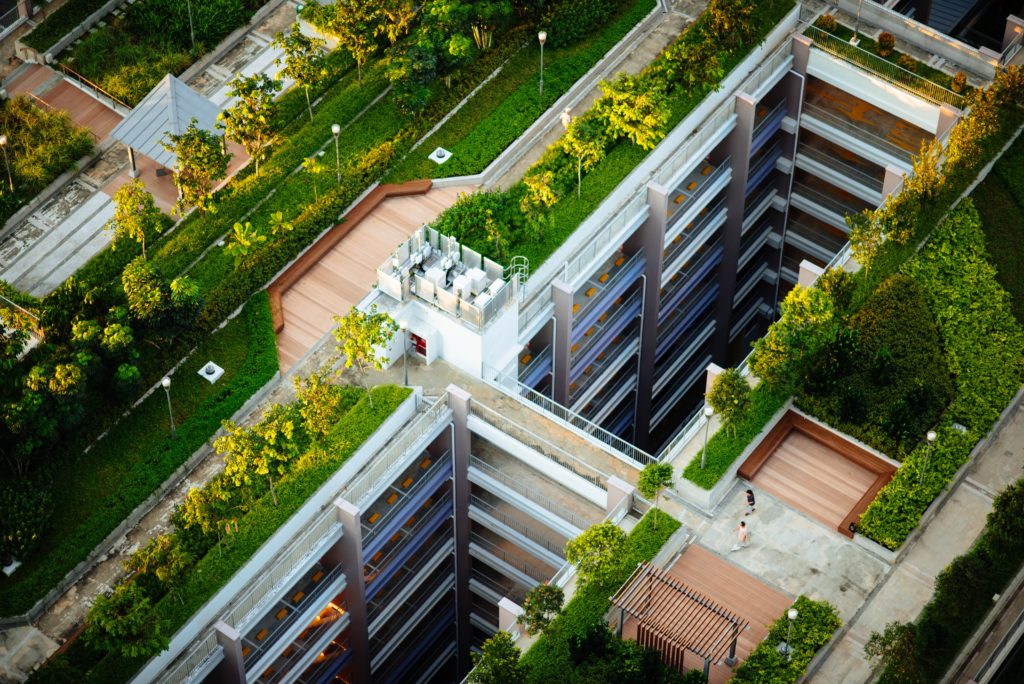The construction sector is the single largest consumer of materials and energy use worldwide. This isn’t a shocking fact when you think about how vast and developed global cities are.
According to the U.S. Green Building Council (USGBC), buildings account for approximately 40% of total energy use, 40% of raw materials use, 30% of waste output, 13.6% of total potable water consumption, 73% of total electricity consumption, and 38% of greenhouse gas (GHG) emissions (USGBC, 2015).
The good news is that green building practices across all segments of the construction sector are paving the way for sustainability and changing the course of its environmental impact for the better.
People expect to live, work and play in healthy spaces, and today’s industry must meet this demand, whether they are building the world’s most iconic skyscraper or renovating a piece of history.
LEED certification helps the industry develop efficient, sustainable, and impressive spaces with credibility and lasting power, all while reducing materials, costs and carbon footprints.

What is LEED?
Leadership in Energy and Environmental Design (LEED) was developed in the late 1990s by the U.S. Green Building Council to establish, measure and certify green building practices.
The LEED certification process provides guidance for all types of buildings, both existing and new construction.
This system provides a framework and foundation for innovation, sustainability, saving resources and costs, and reducing environmental impact. Incorporating LEED into the built environment combats carbon emissions and climate change while supporting human health and safety.
According to the USGBC, green building is a trillion-dollar industry today, and its LEED program has achieved an impressive number of incredible milestones, including:
- More than one billion square feet of recertified LEED space
- Nearly 24 billion square feet LEED registered and certified
- 110,000 projects participating in LEED
- More than 610 million square feet of LEED-certified residential space
(Source: 2021 data – USGBC website)
U.S. Green Building Council
The U.S. Green Building Council was established in 1993 by a trio of passionate founders, David Gottfried, Mike Italiano and Rick Fedrizzi, who wanted to create better buildings.
Within five years, the nonprofit piloted LEED 1.0 and officially launched LEED for New Construction in March 2000.
As green building gained traction, the USGBC continued to grow, and in November of 2003, its first existing building became LEED-certified: the National Geographic Society building in Washington, D.C.
The latest version of LEED – LEED v4.1 – launched in 2019, and today more than 110,000 building projects participate in LEED certification.
The USGBC works with a diverse global marketplace to expand green building, including architecture firms, real estate developers, building owners, contractors, engineers, designers, manufacturers and more.
The organization’s major initiatives include USGBC membership, Center for Green Schools, education and credentialing, advocacy from local to federal levels, and the world’s largest green building conference – Greenbuild International Conference & Expo.
Why become LEED-Certified?
As our planet continues to battle a climate crisis and expectation around healthy spaces grows, the demand for green buildings will rise exponentially. Clients and regulators alike will be striving for sustainability across global marketplaces.
And meeting that demand comes not only with environmental benefits but also significant business benefits. Getting LEED-certified is a win-win for all.
LEED certification carries a variety of valuable advantages:
- Provides accountability and credibility
- Helps companies become leading players in real estate and development
- Saves money and critical resources
- Combats climate change and lowers carbon emissions
- Promotes renewable energy
- Helps build more equitable communities
- Offers major tax and financial benefits
- Supports ESG goals
- Increases building resale value
- Expands global commitment to sustainability
- Creates safer and healthier spaces for people to live, work and play
USGBC research shows that LEED-certified buildings achieve:
34% lower CO2 emissions
25% less energy consumed
11% less water consumed
80 million tons of waste diverted from landfills
89/100 average ENERGY STAR score for LEED projects
25% less energy on average used by LEED buildings compared to commercial buildings
1.3 million tons of coal equivalent saved each year
78 million tons of avoided CO2 emissions
By joining the ranks of LEED-certified buildings worldwide, your building project will be recognized as an industry leader committed to excellence in sustainability and a healthier environment.
How to get LEED Certified
LEED certification evaluates building projects on a points system that addresses the building holistically, looking at a series of key conditions that include carbon, energy, health, indoor environmental quality, materials, transportation, water and waste.
There are four levels of LEED certification, each corresponding with a point value:
- Certified – 40-49 points earned
- Silver – 50-59 points earned
- Gold – 60-79 points earned
- Platinum – 80+ points earned
There is a LEED category for every building project and phase in both existing and new construction:
- Building Design and Construction
- Interior Design and Construction
- Building Operations and Maintenance
- Neighborhood Development
- Homes
- Cities and Communities
- LEED Recertification
- LEED Zero
The latest version of LEED, v4.1, designed to be more inclusive and accessible, raises the bar on previous certification prerequisites and emphasizes operational and embodied carbon. Learn more about LEED v4.1 here.
How does LEED contribute to a circular economy?
LEED certification helps advance the circular economy, aligning much of its evaluation process with climate mitigation, energy efficiency, resource and waste reduction, and sustainability.
Annually, embodied carbon is responsible for 11% of global GHG emissions and 28% of global building sector emissions.
In its Materials and Resources (MR) category, LEED awards credits (points) for:
- Reducing construction and demolition waste to landfills and incineration facilities through recycling and reuse
- Infrastructures that offer recycling storage and collection during occupancy
Likewise, the Construction and Demolition Waste Management credit is awarded to projects that divert increasing levels of materials.
Credits are also awarded in various categories for teams that analyze the supply chain and prevent waste and excess materials before they arrive and procure responsibly-sourced materials,
According to the USGBC, “LEED v4.1 credits represent a framework for advancing a closed-loop economy by increasing market demand for recycled content, healthier materials that can be reused or repurposed in an ‘infinite loop,’ and products that practice responsible sourcing and extraction of raw materials.”
Rheaply helps built environment LEED stakeholders operationalize their closed loop economy goals through the resource exchange of building materials.
Creating a better future for our planet is a shared responsibility, and as a climate tech company, we are thrilled to support industries like construction and demolition and work together to forge a healthier and more sustainable future.
Generate societal value with a ready-made platform and ignite sustainable change in your organization’s procurement practices with Rheaply Resource Exchange.
Pursue LEED objectives by creating demand for salvageable materials to recapture their value when ready for removal and sourcing local reclaimed materials to stop over-purchasing and scale lean construction practices.

